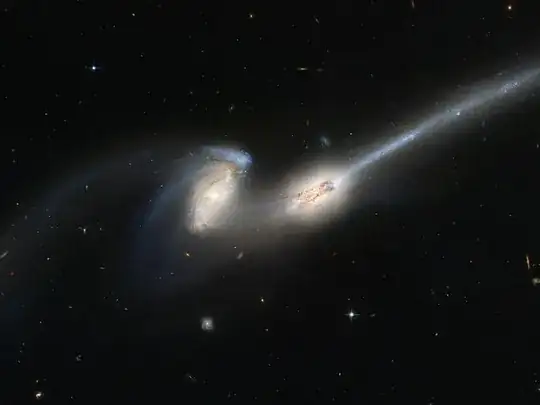Planets orbit around stars, satellites orbit around planets, even stars orbit each other. So the question is: Why don't galaxies orbit each other in general, as it's rarely observed? Is it considered that 'dark energy' is responsible for this phenomenon?
3 Answers
There are plenty of satellite galaxies orbiting larger galaxies. The question is how long are you willing to wait for an orbit?
The Milky Way has a mass $M$ of something like $6\times10^{11}$ solar masses, or $10^{42}\ \mathrm{kg}$. The small Magellanic Cloud is at a distance $R$ of $2\times10^5$ light years, or $2\times10^{21}\ \mathrm{m}$. A test mass orbiting a mass $M$ at a separation $R$ will have a period of $$ P = 2\pi \sqrt{\frac{R^3}{GM}} = \text{2 billion years}. $$ Such a system could undergo at most $7$ orbits in the entire history of the universe. The universe isn't old enough for the nearest major galaxy to have completed a single orbit around us at its current separation.
Even if you did wait long enough, galaxies aren't particularly good at holding their shape. If you put them in a situation where gravity is strong enough to bend their path into a closed orbit, odds are they will also be tidally torn apart by that same gravity. And we see this all the time, as for example with the Mice Galaxies:
They do! There's an entire class of galaxy, called a 'satellite galaxy' which is defined entirely based on them orbiting a larger galaxy (which would be called a 'central galaxy'). Our own milky-way is known to have many orbiting satellite galaxies, or at least 'dwarf-galaxies'. If dwarf-galaxies aren't enough, the milky-way itself is gravitationally bound to the andromeda galaxy, and they are effectively orbitting eachother. Because of the tremendous size-scales, however, the orbital period is billions of years --- in many cases, far longer than the age of the universe, so that a pair like the milky-way---andromeda 'local group' actually hasn't completed a single complete-orbit in the history of the universe. That's why we can definitely never (even hope to) see galaxies orbit in real-time.
- 14,395
galaxy come in many different sizes: some of the small-er ones do rotate ["orbit"] around the edge of a large galaxy ... one can also visualize galaxy-clusters, in which the entire cluster rotates .....
